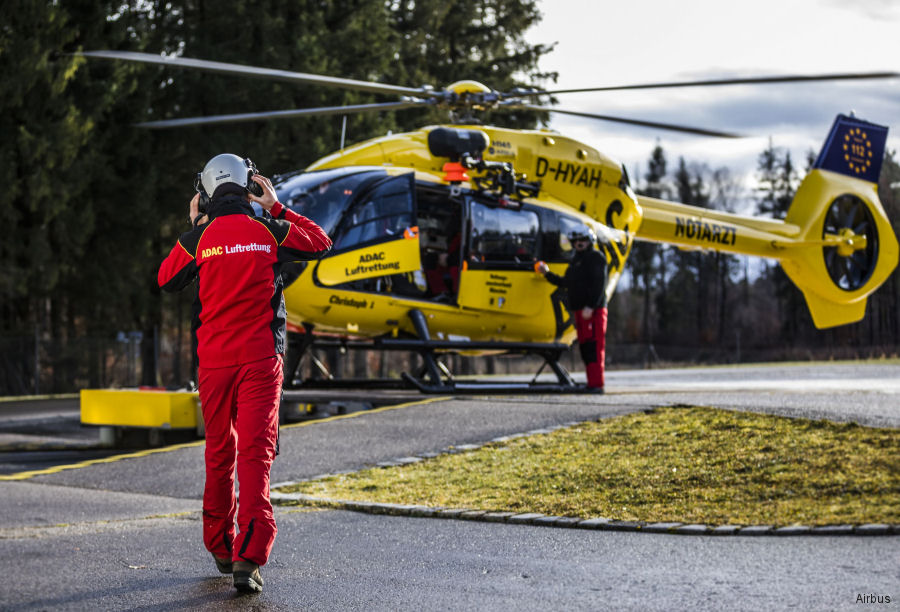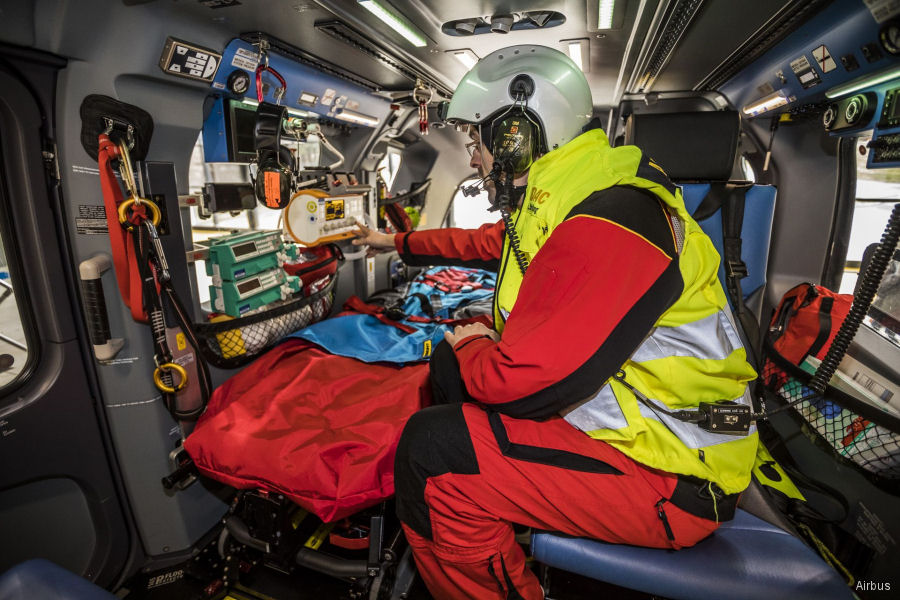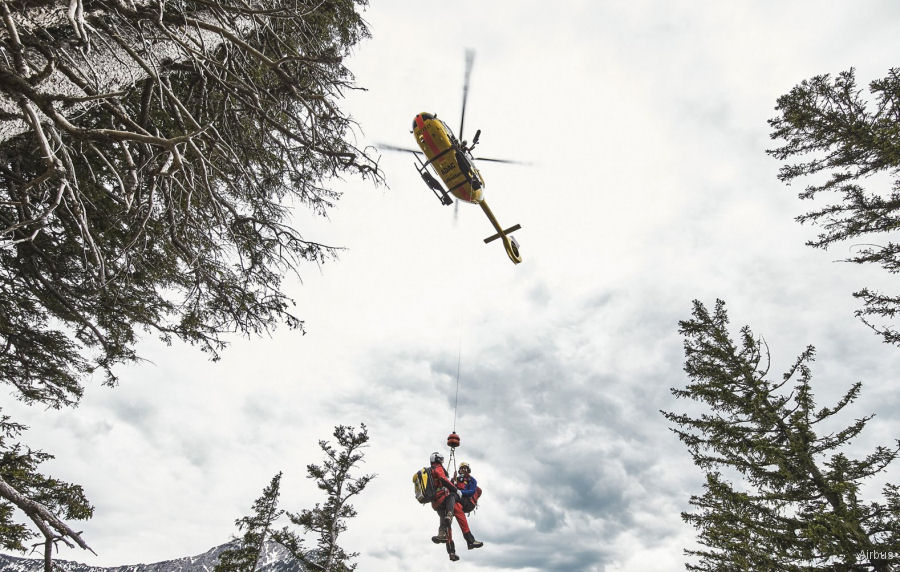
Airbus Helicopters, March 19, 2018 - “When you’re hanging on the winch, it’s good to know there’s an H145 above you that’s able to withstand the wind”, said Rupert Gleissl, an engineer at Airbus in Donauwörth, Germany, and a volunteer operations manager
Gleissl knows better than anyone that sometimes the difference between life and death comes down to a matter of minutes.
Operations you don’t forget
The H145 circles just above the treetops of the Wolfsschlucht, a gorge at Lake Tegernsee. It’s the middle of the night and, down in the gorge, a woman who has been missing for some time is crouched, shivering from the cold. Above her, in the helicopter cabin, Rupert Gleissl is checking the harness and equipment. He hooks up the winch, opens the door and makes his way down. Just before he touches down, he switches on his headlamp. He secures the missing woman, and they are pulled upwards – rescuing her from the gravest danger.
“The woman would hardly have survived another night,” says Gleissl later. “These are operations you don’t forget.” Gleissl, 41, is an engineer at Airbus' helicopter site in Donauwörth, Germany, and a volunteer operations manager and mountain rescuer for the mountain rescue service in Rottach-Egern in Bavaria, Germany. The helicopters he uses during his operations are built by Airbus.
Teamwork between cockpit crew, winch operator and rescuer on the winch
“Our mountain rescue team is called out to the Tegernsee Valley around 250 times a year, and close to 50 of these operations involve helicopters,” says Gleissl. It is Friday afternoon. After working from home, Gleissl is on duty as operations manager at the rescue station. Gleissl and his colleagues discuss their missions, how they fly seriously injured tobogganists to hospital and rescue canyoning adventurers from raging waters. “Winching seven people one after the other from a narrow, water-filled gorge is a challenge,” admits Gleissl. To ensure everything runs smoothly, it is essential that the cockpit crew, winch operator and the rescuer on the winch work well with each other.
The mountain rescue service doesn’t operate its own helicopters. It works with air rescue crews from Germany’s ADAC automobile association, the German air rescue organisation DRF Luftrettung, the Bavarian state police, the German federal police and air rescue services close to the border in Austria. When an emergency call comes in, Gleissl decides whether a helicopter needs to be requested, depending on the situation. “The type of helicopter used depends on whether we need a winch or an emergency doctor on board,” explains Gleissl.
Alert at the Helicopter base of Christoph 1 in Munich
If the rescue coordination centre dispatches the Munich-based ‘Christoph 1’ medical helicopter, for example, the pagers of the fourstrong crew sound, and paramedic Stefan Schatz notes the operational details. ‘Christoph 1’, an H145, is one of five ADAC winch-equipped rescue helicopters that fly to emergencies in Bavaria several times a day. The destination is noted, helmets are put on, the helicopter is started and the crew run to take their places. “Two minutes after the alert, we’re in the air,” explains pilot and station manager Roland Benning. Benning is particularly impressed with the Airbus Helionix avionics system: “It’s easy to use and simplifies our work in the cockpit. While the helicopter’s on autopilot, I can monitor the surroundings.” As the rescue helicopters have to land anywhere, it is often necessary to avoid paragliders, camera drones or onlookers on the ground, for example. “Many people will approach the helicopter without being aware of the risks,” says Benning.
Strong wind in the mountains
Rescue missions in the mountains depend in particular on engine performance. “Constantly changing winds and turbulence close to steep mountain faces create problems for us, especially on hot summer days with a foehn wind [a warm down-slope wind on a mountain leeside],” explains Benning. “The H145 copes with these conditions much better than older models.” The mountain rescuers also value the reliable helicopter. “When you’re hanging on the winch, it’s good to know there’s an H145 above you that’s able to withstand the wind,” says Gleissl.
Engineer with a user perspective
Gleissl shares his knowledge of helicopter construction and mountain rescue at Airbus in Donauwörth, when he gets together with the developers and discusses details, such as the easiest way to get through the door with a 15kg air rescue sack and rucksack on your back. “I know things from the user’s perspective and know what a helicopter can do and how it reacts in certain situations,” he explains. “This enables us to enhance the helicopters even further.”
Gleissl knows better than anyone that sometimes the difference between life and death comes down to a matter of minutes.
Operations you don’t forget
The H145 circles just above the treetops of the Wolfsschlucht, a gorge at Lake Tegernsee. It’s the middle of the night and, down in the gorge, a woman who has been missing for some time is crouched, shivering from the cold. Above her, in the helicopter cabin, Rupert Gleissl is checking the harness and equipment. He hooks up the winch, opens the door and makes his way down. Just before he touches down, he switches on his headlamp. He secures the missing woman, and they are pulled upwards – rescuing her from the gravest danger.
“The woman would hardly have survived another night,” says Gleissl later. “These are operations you don’t forget.” Gleissl, 41, is an engineer at Airbus' helicopter site in Donauwörth, Germany, and a volunteer operations manager and mountain rescuer for the mountain rescue service in Rottach-Egern in Bavaria, Germany. The helicopters he uses during his operations are built by Airbus.
Teamwork between cockpit crew, winch operator and rescuer on the winch
“Our mountain rescue team is called out to the Tegernsee Valley around 250 times a year, and close to 50 of these operations involve helicopters,” says Gleissl. It is Friday afternoon. After working from home, Gleissl is on duty as operations manager at the rescue station. Gleissl and his colleagues discuss their missions, how they fly seriously injured tobogganists to hospital and rescue canyoning adventurers from raging waters. “Winching seven people one after the other from a narrow, water-filled gorge is a challenge,” admits Gleissl. To ensure everything runs smoothly, it is essential that the cockpit crew, winch operator and the rescuer on the winch work well with each other.
The mountain rescue service doesn’t operate its own helicopters. It works with air rescue crews from Germany’s ADAC automobile association, the German air rescue organisation DRF Luftrettung, the Bavarian state police, the German federal police and air rescue services close to the border in Austria. When an emergency call comes in, Gleissl decides whether a helicopter needs to be requested, depending on the situation. “The type of helicopter used depends on whether we need a winch or an emergency doctor on board,” explains Gleissl.
Alert at the Helicopter base of Christoph 1 in Munich
If the rescue coordination centre dispatches the Munich-based ‘Christoph 1’ medical helicopter, for example, the pagers of the fourstrong crew sound, and paramedic Stefan Schatz notes the operational details. ‘Christoph 1’, an H145, is one of five ADAC winch-equipped rescue helicopters that fly to emergencies in Bavaria several times a day. The destination is noted, helmets are put on, the helicopter is started and the crew run to take their places. “Two minutes after the alert, we’re in the air,” explains pilot and station manager Roland Benning. Benning is particularly impressed with the Airbus Helionix avionics system: “It’s easy to use and simplifies our work in the cockpit. While the helicopter’s on autopilot, I can monitor the surroundings.” As the rescue helicopters have to land anywhere, it is often necessary to avoid paragliders, camera drones or onlookers on the ground, for example. “Many people will approach the helicopter without being aware of the risks,” says Benning.
Strong wind in the mountains
Rescue missions in the mountains depend in particular on engine performance. “Constantly changing winds and turbulence close to steep mountain faces create problems for us, especially on hot summer days with a foehn wind [a warm down-slope wind on a mountain leeside],” explains Benning. “The H145 copes with these conditions much better than older models.” The mountain rescuers also value the reliable helicopter. “When you’re hanging on the winch, it’s good to know there’s an H145 above you that’s able to withstand the wind,” says Gleissl.
Engineer with a user perspective
Gleissl shares his knowledge of helicopter construction and mountain rescue at Airbus in Donauwörth, when he gets together with the developers and discusses details, such as the easiest way to get through the door with a 15kg air rescue sack and rucksack on your back. “I know things from the user’s perspective and know what a helicopter can do and how it reacts in certain situations,” he explains. “This enables us to enhance the helicopters even further.”


H145D2 / EC145T2 D-HYAH ( ADAC Luftrettung )
See also |
H145D2 / EC145T2 in




